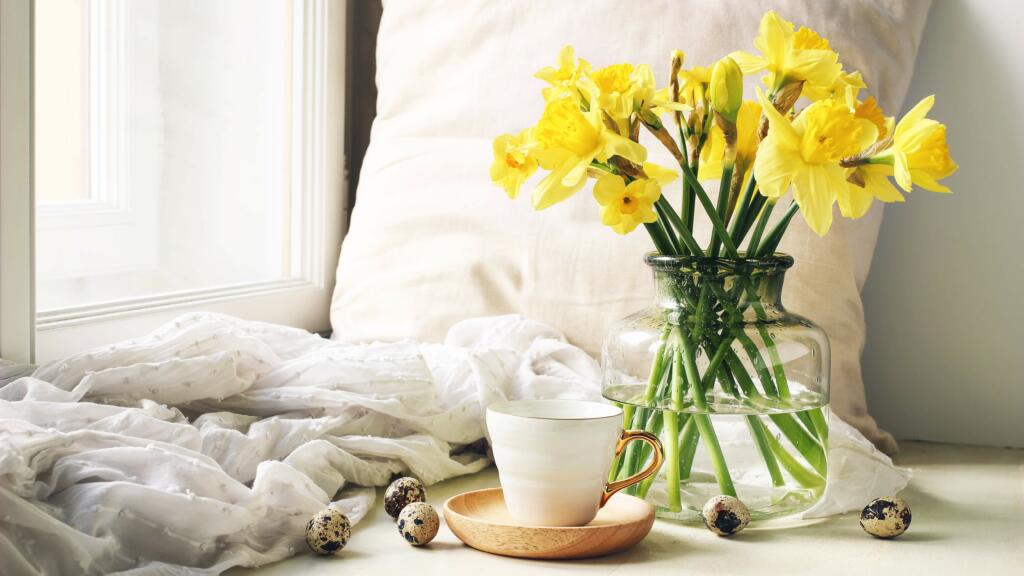
10 breathtaking photos from gardens around the world
Rosanna Spence
Stimulate all five senses with therapeutic gardening.
Any garden, big or small, has all the key elements you need to create a sensory garden. It’s how you assemble these building blocks that makes the difference.
Holding a shell to your ear to listen to the ocean, smelling lavender in the air and pricking your finger on a thorn while foraging blackberries are all sensory experiences. Even looking at a field from your car window on the motorway is a sensory experience, though it may not feel like it at first.
Any garden, big or small, has all the key elements you need to create a sensory garden. It’s how you assemble these building blocks that makes the difference.
Holding a shell to your ear to listen to the ocean, smelling lavender in the air and pricking your finger on a thorn while foraging blackberries are all sensory experiences. Even looking at a field from your car window on the motorway is a sensory experience, though it may not feel like it at first.
 Credit: Shutterstock / Ground Picture
Credit: Shutterstock / Ground PictureNow imagine a whole garden (or just a section of one) designed specifically to stimulate the five senses – sight, sound, touch, smell and taste.
Sensory gardens are often created as part of community projects, and you’d be forgiven for assuming they’re usually designed for children.
But sensory gardening can be useful in our homes no matter our age. It can be used to support and engage people who may have autism or ADHD, or could simply benefit from its therapeutic power.
A sensory garden can be filled with flowers or look more like a vegetable patch. But every feature, whether that’s a plant, the ground texture, or any other object you choose to include must stimulate one or more senses.
“It’s the concentration of experiences that defines a sensory garden”
“A sensory garden is different to a traditional garden because it purposefully includes features with sensory qualities,” says Milly Sell, content designer at gardening for health charity Thrive. “This could be through plant selection, ornaments, hard landscaping or other materials.”
Sensory Trust defines these mindful gardens as “a space with a principal focus on sensory experience”. All landscapes are sensory, the organisation says, but some are more sensory than others. It’s “the concentration of experiences that defines a sensory garden or trail”.
 Credit: Shutterstock / Peter_Fleming
Credit: Shutterstock / Peter_FlemingSensory gardens can often be designed with a gentle theme or purpose in mind. Do you want people to feel relaxed, or energised, for example? The colours, sounds and objects included will often all contribute to this.
The best thing about a sensory garden is that is can be as big or small as you like. But every sensory aspect must be chosen with the user(s) in mind.
A sensory garden could be designed for a partner who might perhaps be experiencing symptoms of dementia. Or for grandchildren who might benefit from educational, tactile gardening.
As with any garden, a sensory garden can offer practical benefits to enhance your outdoor oasis.
Perhaps it includes a comfy seating or dining area, provides wheelchair-accessible routes through plant beds. Or simply offers shade or shelter from the elements.
 Credit: Shutterstock / Rawpixel.com
Credit: Shutterstock / Rawpixel.comThe magic of a sensory garden is that it can be created to suit a huge range of specific needs. This depends on who is living in, or will be visiting, your home.
Sensory gardens can also encourage mindfulness thanks to their ability to help us connect with and respond to our immediate surroundings, and nature’s grounding effect.
Sell explains that because sensory gardens can be designed to have different effects, they appeal to people with a wide variety of conditions. These spaces can be calming or stimulating.
 Credit: Shutterstock / wavebreakmedia
Credit: Shutterstock / wavebreakmediaThere are many benefits that sensory gardens can bring to different people, as Sell explains:
When you’re planning a sensory garden, it’s useful to base every choice of plant or object on the needs of those who will be using and benefitting from the sensory experiences you want to create.
This is a space to be creative, and there are no hard rules (though there are a few things you might want to avoid, but we’ll get onto that later).
If you’re creating a sensory garden for your grandchildren to use, it may include more engaging, energetic features, rather than opting for a relaxing space an adult may prefer. Many sensory gardens are still successful when you blend the two.
 Credit: Shutterstock / JimboMcKimbo
Credit: Shutterstock / JimboMcKimbo“Stimulating features, such as vibrant plant colours, wind chimes and distinctive topiary or shapes may be more appropriate for children,” says Sell.
“More interactive and playful features may also work well, such as play sculptures, mirrors, a sandpit or outdoor musical instruments.”
She does acknowledge that adults may also enjoy a stimulating sensory garden, though they often get more benefits from a calming environment: “In this case still water [like the DIY mini pond below], pastel-shade plants, curved lines and slightly wild-looking planting are good features.”
Regardless, everything should stimulate at least one of the five senses. This means that someone with sight loss, for example, would still be able to build their own vision of the garden by feeling, smelling, hearing and tasting various elements.
Think about including bright, engaging, diverse colour palettes that provide visual stimulation year-round. Patterned leaves and stems and unusually shaped flowers are a good place to start.
“The coloured leaves and stems of chard and beetroot look pretty in the off-season and heuchera, a low-growing ground cover perennial with charming, crinkled heart-like leaves, is available in yellow to deep purple,” says the Royal Horticultural Society’s (RHS) chief horticulturist Guy Barter, in his tips for what to include in a sensory garden on the RHS’s website.
“Cyclamen have curiously patterned silvery-green leaves, particularly cyclamen hederifolium, which is an ivy-leaved plant. Ivy is also quite patterned, as is the shrub osmanthus heterophyllus [holly olive] ‘Variegatus’, with its holly-like leaves.
“Garden centres are full of multi-coloured shrubs, while snake bark maples (acers) provide interesting winter patterns.”
Objects like windchimes, grasses and plants that have hard seed pods that can be shaken, or which make a calming sound when blowing in the wind, are a good idea, as are plants that encourage chirping and buzzing sounds from birds and insects.
“Love-in-a-mist (nigella) seed heads appear after the plant has produced blue flowers while grasses (miscanthus and brizia) are good for sunny and dry spots,” says Barter.
“Bamboos are less dry-tolerant and can become invasive, but phyllostachys is usually well-behaved. Annual grasses, such as millets and sweetcorn, can also suit smaller gardens.”
Plants with a strong scent are easy wins here, but you’ll get more engagement with these sensory elements if you have growing conditions that can support these plants at different times of year.
“Houttuynia cordata ’Chameleon’ has lemon scented foliage, and mint is useful for scent and will tolerate light shade,” says Barter.
“Chives have a mild onion scent and taste, with pretty pink to purple flowers, and can be planted in shady areas.
“Plants that are beautifully scented on warm days include the curry plant (helichrysum italicum), lavender, oregano, rosemary, sage, thyme and many pelargoniums, commonly called geranium.
“Winter-flowering honeysuckle produces scented flowers in mid-winter, but it needs a sunny spot and shelter from winds to thrive.”
Growing fruit trees and bushes, or even a whole vegetable garden are great ideas if you have the space. But smaller patches or pots can see herb plants flourish, as well as edible flowers.
“Chard and beetroot leaves give an earthy flavour,” says Barter.
“Nasturtiums provide caper-like edible fruits and vivid edible flowers, atop charming, rounded foliage, but are frost-sensitive.
“Alpine strawberries are easy to grow, relish shade and make good ground cover with little highly-flavoured fruits all summer.
“Herbs such as basil, coriander, dill, fennel, parsley and sage all make fine summer plants that grow well in sunny places.”
Opt for textured plants, perhaps with soft, furry leaves. But bear in mind that these plants need to be robust to withstand repeated touch.
“Lamb’s ears (stachys byzantine), rose campion (lychnis coronaria) and salvia argentea, offer felt-like grey leaves,” says Barter.
“The rabbit tail-like seed heads of grasses, such as pennisetum, are tactile, cistus and petunias are slightly sticky, and in a garden can contrast with leathery-leaved hostas and sedums.
“Sempervivens and other succulents are pleasantly tipped and robust enough to take people touching them.
“Some plants have a stringy form that’s appealing. Ornamental sedges such as carex, as well as heathers, the grass festuca glauca and santolina, which is a low shrub with aromatic leaves and shrubby brooms, are all good choices.”
As with any garden planning, though it’s wonderful to let your creativity run wild, there are a few ground rules to remember – especially when you’re choosing plants people will be interacting with physically.
Avoid plants that are too delicate to withstand touch, and steer clear of objects that could break or don’t suit all outside weather conditions. Sharp or toxic plants that appeal to one sense but are dangerous to another should also be left out of your sensory garden.
Any plants that are more difficult to care for may well become bothersome, especially if you spend a lot of time caring for someone in your household.
 Credit: Shutterstock / BeataGFX
Credit: Shutterstock / BeataGFXIf you’re planning your sensory garden with a specific person in mind who may have additional needs, their comfort and enjoyment may affect your decorative choices. Don’t forget to leave out any smells or tastes they don’t generally like, too.
“Because sensory gardens can be so easily tailored, it’s a good idea to avoid items that could cause emotional distress or confusion to those using it,” says Sell.
“For example, water features made of shiny metallic material may be lovely for some people. But those living with dementia may find them confusing and difficult to interpret.
 Credit: Shutterstock / Peter Cartledge
Credit: Shutterstock / Peter Cartledge“If you are hoping to create a sensory garden with a calming effect, avoid overfilling the space with features with broad sensory appeal. Too many competing scents together, for example, may create a negative response.”
People without a garden can still create sensory experiences using natural plants and objects anywhere in the home.
Windowsill gardening is a great option if you’re lucky to have bright, sunny windows. Though you can always opt for plants and objects that thrive in shady spots too.
“Houseplants can offer great visual appeal, with many different textures and shapes available,” says Sell.
 Credit: Shutterstock / KlavdiyaV
Credit: Shutterstock / KlavdiyaVDedicated trays can be used for activities at a table (and they can also contain mess from soil and other debris).
TIP: If you’re curious about creating your own sensory garden at home, why not plan a visit to one of the best in the UK and soak up some inspiration?
A quick Google search should also tell you if there are any community sensory garden projects near you.

Written by Rosanna Spence she/her
Published: Updated:
Rosanna Spence has been a journalist for nearly 10 years, reporting on a huge array of topics – from microwaves to cocktails, sustainable buildings, the Caribbean islands and beyond. She’s interviewed chefs at the helm of Michelin-starred restaurants and chatted to countless CEOs about their businesses, as well as created travel guides for experienced travellers seeking life-changing adventures. Throughout her career, she has created content for Business Traveller, i-escape.com, Pub & Bar, BRITA, Dine Out and many more leading titles and brands.

Rosanna Spence

Rosanna Spence

Rosanna Spence

Rosanna Spence

Lucy Summers